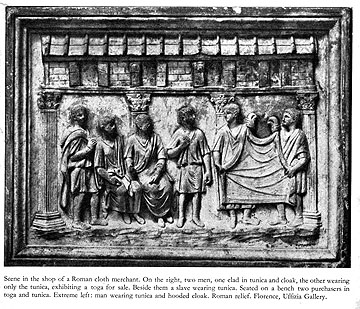
Ciba 9: Dyeing and Tanning in Classical Antiquity
By G. A. Faber
Basle, May 1938
Back to the Dye Woorkes
Dyeing in Greece
By G.A.Faber
In his history of Greece B. Curtius expresses the opinion that the art of dyeing fine woollen goods was brought to Greece from Phoenicia with the cult of Aphrodite. This assumption, which makes Phoenicia the original home of purple-dyeing, can only hold good for articles distinguished by artistic perfection, as the art of dyeing plain textiles with natural dyes had long been known to Greece. On more than one occasion Homer mentions dyed textiles in a manner which leaves no room for doubt. Judging from the descriptions of their appearance, Nestor, Thoas, and Telemachos wore robes of Phoenician red, known as Chlaina. Ulysses and Agamemnon wore voluminous cloaks of some dark coloured, glossy material, and we are told that Laodice in Troy was especially renowned for the manufacture of such garments. Rugs of the same irridescent material were spread over chairs and beds. The Queen of the Phaeacians spins purple threads, and the water-nymphs weave cloth "purple as the sea".
It is an open question whether the women dyed the wool themselves, or used material already dyed; it may, however, be noticed that according to Homer the women of Caria and Lydia displayed remarkable skill in staining ivory purple. The poetess Sappho (6th century B.C.) extols the Lydian art of making purple straps for sandals. In the Odyssey the leather straps on Ulysses' bed are of purple, and a purple belt given by Ajax is described as a particularly valuable present. The tail of the charger of a noble Trojan warrior is dipped in purple to give it a more splendid appearance. That the Homeric warriors were familiar with dyes may also be inferred from the fact that they painted their ships red. The earliest evidence after Homer, which points to the existence of dyeing, names Hermione in Argolis, as a town where already in the 6th century B.C. the craft was practised with great skill and perfection. The textiles of Hermione were traded even to Persia, especially for the use of the Persian court; they were purple with broad white stripes in the middle. These purple stuffs were treated with honey, and the broad white stripes were produced by means of white oil. The durability of these stuffs must have been extraordinary, for when Alexander the Great took the town of Susa he
found there 5000 talents of stuffs from Hermione (I talent = 54 pounds) which had lain there for 190 years without losing any of their brilliance. According to the poet Aeschylos, Clytaemnestra, the wife of Agamemnon, spread purple carpets of Hermione on the ground when her husband returned from the Trojan wars. Almost as old as the evidence for Hermione is that which tells us that purple-dyeing was also carried on in the town of Itanos on the island of Crete; it is at least certain that purpura fishing was practiced there.
Not only dyeing with purpura juice, but also with kermes was common in Homer's day. The kermes dye trade of Sardes, the capital of Lydia, was so well-known that the expression "the red bath of Sardes" became proverbial.
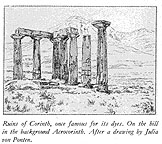 Before discussing in detail the dyes and the technique of their use, it might be appropriate to say something of the towns where, according to tradition the centres of the Greek dyeing-industry were situated. In Thessalia, where a great deal of the dye was produced, the workshops of the town of Meliboea are highly praised by ancient writers; to this day silks are dyed at Ampellachia with purpura juice. In the Phoecian town of Bulis in the Gulf of Corinth more than half the population were engaged in fishing for purpura shell-fish. Good scarlet was produced near Ambrosus. Boeotia, which produced principally metal-work and pottery, also had a certain output of purple which came from the region of Anthedon. Corinthian coins bear the purpura shell-fish. as a device, a fact which points to the importance of the dyeing industry, and from Corinth came those rugs embroidered with fantastic animals in the style of Corinthian pottery.
Before discussing in detail the dyes and the technique of their use, it might be appropriate to say something of the towns where, according to tradition the centres of the Greek dyeing-industry were situated. In Thessalia, where a great deal of the dye was produced, the workshops of the town of Meliboea are highly praised by ancient writers; to this day silks are dyed at Ampellachia with purpura juice. In the Phoecian town of Bulis in the Gulf of Corinth more than half the population were engaged in fishing for purpura shell-fish. Good scarlet was produced near Ambrosus. Boeotia, which produced principally metal-work and pottery, also had a certain output of purple which came from the region of Anthedon. Corinthian coins bear the purpura shell-fish. as a device, a fact which points to the importance of the dyeing industry, and from Corinth came those rugs embroidered with fantastic animals in the style of Corinthian pottery.
The position of Sparta with regard to dyeing was very peculiar. The severe laws of the city banished the dyers from the community, because they robbed the wool of its natural white. In the Spartan language the word "dolun" meant both to dye and to deceive, as dyeing was regarded as a falsification of Nature. Nevertheless the strictest laws tend to become less rigid with time, especially as the Laconian coast and the island of Cythera provided a magnificent shade of purple, according to Pliny the best in Europe. Moreover, in defiance to their own law the Spartans had their battledress dyed scarlet (not purple) by the Perioecians, a class of people considered to be of inferior caste. The reason for this was to prevent the blood from showing when they were wounded.
Cythera was actually known as the "purple island", and the purple of Amyclae is often praised by the poets. The scarlet shoes of Sparta, famed throughout the Old World, came from the workshops of Amyclae. Numerous dye-works also existed on the Greek islands. The famous workshops of Corinth were supplied with dye from the island of Euboea. The rich robes described in Athenian inventories as especially precious came from the isle of Amorgos. They were reddish in colour, dyed with "amorge", a plant presumably identical with orseille. At a very remote period the Phoenicians introduced embroidery in colours into Thera.
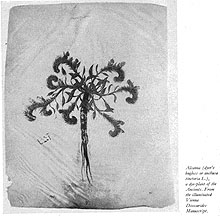
For the rituals of Apollo and Dionysos, which were common to the whole of Greece, garments from Thera were worn, for instance by the Athenian youths who danced round the temple of Apollo of Delos during the ceremony in his honour. These robes were interwoven with the coloured figures of fantastic animals. Crete had long been a seat of the dyeing trade. A dyer from the town of Itanos is mentioned by Herodotos. Dyeing was performed both with purple and with the juice of sea-weed, perhaps also orseille. If we turn to Asia Minor we find the Phrygians, the inventors of embroidered dress. In Heriapolis, the capital of the country, a town originally known as Mabog, the cotton city, there was a dyers' guild. The water there was considered particularly well-suited to the trade. Dye-roots were used. In the Greek cities of Asia Minor, especially the Ionian ones, dyeing was carried on on a large scale. Alexander the Great, who loved luxury of dress, both for himself and his officers, imported from there and from the island of Chios dyed cloths. Milet exported rich rugs and costly clothing, which were dyed in the workshops of the town. Silk, too, was dyed at Milet. The Sybarites, inhabitants of Sybaris in the South of Italy, and renowned for their love of luxury, wore silks of Milet. Carpets, rugs, curtains, woven and beautifully embroidered in colour, were exported all over the world. Pergamon alone could vie with Milet in its gold-brocaded cloths. On the coasts of Chios, Rhodos, and Cyprus purple of excellent quality was found, and it may safely be inferred that dyeing was carried on there as well as weaving and brocading.
As is shown by the foregoing the dyer's craft was very wide-spread in Greece and her colonies. Though for every-day wear, the wool, which was available in unlimited quantities, retained its original colour, either bleached or unbleached, there was also a strong demand for colour, which led to the growth of the dyeing trade. The Greek sense of beauty, the great prosperity of the period, the influence of the East, where luxury in dress had reached an extreme, all these factors provided an additional stimulus to the craft. Only in remote rural districts was dyeing as well as weaving and spinning the cloth done by the women. In the towns flourishing workshops sprang up. The technical name for the craft was derived from its principal process, "baptein", which means to dip or to immerse. The dyer was the "dipper", his workshop the "dipping shop". It was usual to dye the wool rather than the finished material, and the same practice was observed with silk and linen. The prime necessity was to achieve colours which were fast to light and water. As we speak of saturated colours, the Greeks expressed the same thing by saying the material had "drunk its fill". The charm of such cloth is its beautiful and lasting gloss. To achieve this the materials were treated with a mordant before dyeing. Then as today alum was used, for light materials the white, for darker ones the black variety. An alternative to alum was soapwort, which together with a chalk-bath, was used by the Jews to assist the penetration of the dye. At a later period the Greeks also used salt of tartar as a mordant. When the wool had been thus prepared it was placed in the dye -bath, allowed to draw for five hours, then removed, combed, and reimmersed. This process, in which the bath was either quite cold or kept at the boil, was repeated until the dye had entirely permeated the cloth. A wooden implement known as the kykethron was used for stirring. Several vegetable dyes were used by the Greeks.
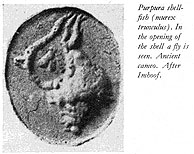
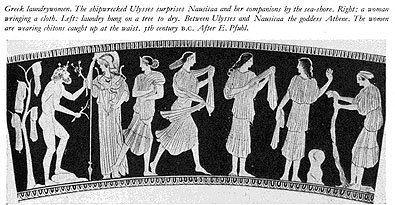
Madder (rubia tinctorum L.) was known as Erythrodanon, i.e. dyer's red. Dioscurides, whose description of all the plants known to the Ancients also tells of their use, speaks of its red roots and widespread, profitable cultivation. Saffron (crocus sativa L.) was used for dyeing yellow. Plutarch states explicitly that before being dyed with saffron, the materials were treated with alum. Saffron yellow was particularly popular for women's clothing. Woad or dyer's-woad (reseda luteola L.) was also used as a yellow dye. Theophrastus the naturalist (37T-287 B.C.), a pupil of Aristotle, describes a shade of blue obtained by means of woad (isatis tinctoria L.). This statement is upheld by Dioscorides. Gallnuts served a two-fold purpose, providing both a dye and a mordant. Clothes dyed with oak-bark also find mention. A plant used by women to dye their hair, thapsus (thapsia asclepium L.) also served for dyeing wool yellow. The name is either derived from the river Thapsus or from the island of the same name. According to Dioscorides the root of the lotus served the same dual purpose. The outer shell of fresh walnuts, broom, and the pomegranate-flower (also well-known to medicine), all served as dyes. There are also grounds for the belief that the Greeks manufactured indigo much as we do today. The descriptions given by Dioscorides and Pliny of a colour known as atramentum indicum are confused, but the expert may infer from them that indigofera tinctoria L. was already known to the Greeks. According to these descriptions they placed the indigo plants in stagnant water until they were putrefied, then removed them and scrap off the dye which had collected.
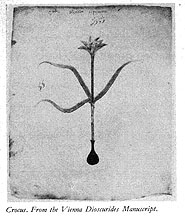
Today the process takes place in the steeping-vat. In India, whence the plant was brought to Europe, and in Malta, the same procedure was followed. In concentration the colour appears jet-black, when diluted it forms a mixture between blue and purple. Indigo being very expensive, the Greeks used a substitute which was as suitable for dyeing as genuine indigo. It will be remembered that the woad-dyers of the 16th century sold a dye made in their own vats, instead of the more expensive indigo. For the dyeing of hair-ribbons and scarfs, but also for robes and mantles, orchella (lichen roccella L.), a plant growing on rocks in the sea, was used. While fresh the dye produced from this weed surpassed genuine purple in lustre, but the action of a base turns the colour to blue. As the Greeks used substances for washing which contained acids and a predominant base, the garments lost their original colour when washed. Dyer's bugloss (anchusa tinctoria L.) was also used as an independent dye. Unfortunately, Pliny's reports on dyeing are very sketchy, as the craft was not considered worthy of a free man. Therefore a number of plants, whose dyeing-qualities were known to the Greeks receive no special mention, though they were in all probability used. Such are rhamnus infectorius L., used for dyeing the hair, the wood and bark of sumach (thus coriaria L.) as a yellow dye, the leaves and green twigs of the same plant for grey; the same plant was also used for tanning, which probably led to the discovery of its dyeing qualities.
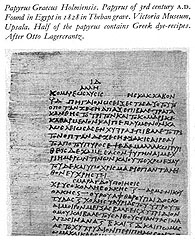
Mineral dyes were not used by the Ancients, but something must yet be said of the animal dyes then in use. The most important aspect of this question is that of the dye extracted from various kinds of shell-fish, with which our readers will be acquainted (cf. Ciba Review No. 4, "Purple"). On a bronze coin from Tyre we see under a tree and among rocks a dog sniffing at a shell-fish, murex trunculus. In this way the ancient story, according to which Hercules' dog discovered the dyeing power of the shell-fish when he crushed one with his teeth, was perpetuated officially on the coins of Tyre. Purple of Tyre was the most famous and the most expensive throughout the Old World. The juice of two species of shell-fish was used, keryx and the purpura shell-fish porphyra. According to the very exact descriptions given by ancient writers the purple juice was situated in a tiny vein between neck and liver of the shell-fish, a very small quantity of dark red, almost black liquid, called by the Greeks "anthos", the blossom. The juice of the triton, known as bucinum, was similar to scarlet, it had no lasting qualities and was therefore not used alone. Lacaze-Duthiers established the fact that the juice contained in the purple-gland is subject to photo-chemical changes when exposed to light. The colour-scale moves from yellow to blue, through mixture of both to green, and then from red to violet. If the process is interrupted, intermediary shades of great beauty are attained, especially of a bluegreen colour. Lacaze-Duthiers proved further that the final shade is always purple, though varying occasionally in tone. From that it may be inferred that the Greek dyers changed the natural purple by artificial means.
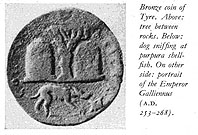
The use of the kermes insect (coccus ilicis L.) among the Greeks has been discussed in an earlier issue of this journal (cf. Ciba Review No. 7, "Scarlet"). Apart from the conchyliae, kermes was the only animal dye used by the Ancients. Kermes dye was expensive, but it was cheaper than purple, and therefore frequently used as a substitute for it. Dioscorides already expressed the opinion that kermes is not a plant, but an animal.
A brief scrutiny of the dyers' recipes which have come down to us may be appropriate at this point. Among the Greek alchemists there existed an old story according to which the famous philosopher Democritus, in the course of his wanderings came to Memphis, in Egypt. In the temple there he was initiated into the secrets of the priests, and became familiar with their teachings and writings. Based on this knowledge were four technical books on dyeing which he is said to have written. Similar to these supposed books of recipes or works like them are the papyri which have come down to us as the two oldest works on chemistry. They date from the 3rd century A.D., and were discovered in 1828 when the grave of some friend of the occult sciences was opened at Thebes. The one which interests us in this connection is known as Papyrus Holmiensis. It was presented to the Swedish Academy at Stockholm by the Swedish-Norwegian vice-consul Anastasy who played an important part in the history of papyri. For seventy years it lay neglected at Stockholm, till it was brought to Upsala in 1906, and published in a fine edition by the Swedish philologist Lagercrantz.
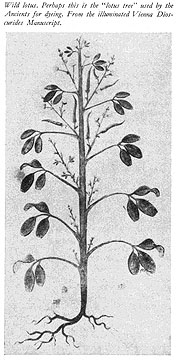
In order to convey an impression of the recipes contained in the collection, a few of those relating to vegetable dyes may be given here. A recipe for dark blue: "Put about I talent (50 lb.) of woad into a vat placed in the sun and holding not less than 15 metretes (Greek liquid measure, about 10 gallons) and press it down carefully. Then add urine till the woad is covered, and place it in the sun to warm. Next day, work the woad by kneading it in the sun; this process should be repeated on three successive days." To boil woad: "Divide the woad and the urine covering it into three parts; stir one part in a suitable manner, put it in a pot on the fire. You can tell by the following means whether the woad has boiled. When it begins to boil, stir carefully, lest it should sink, and so spoil. When the woad splits in the middle it is boiled enough. Then remove the fire, but continue to stir. Cool the bottom of the cauldron by spraying with cold water. Then add half a choenix (1 pint) of soapwort to the vat, and pour boiled woad over it. Lay poles across the top of the vat, and cover with mats. Keep a moderate fire under the vat, but let the mixture neither boil over nor grow cold. Leave for three days. Boil up the urine and soapwort, skim off the scum, and put in boiled wool. Then rinse, and squeeze the wool, comb it in place in the dye-bath. When it has been in long enough remove it, cover up vat, and light fire under it as before. (Note that according to modern methods no fire is kept going under the vat.) Add about 2 ozs. of orseille to the liquid, but boil and skim it first. Then immerse the dyed wool. Rinse in salt water, and allow to cool. Dye twice a day, morning and evening, as long as the bath is good."
The use of blue as a preliminary to red is often recommended in these recipes, thus for the achievement of a "rose colour" with scarlet dye: "Dress the wool with blue, which is called blueing. Wash and dry the wool, then dissolve kermes in water, mix with common orchil and boil. Immerse the wool and it will become scarlet." This shows that woad was not used as a mordant, but to blue the wool in preparation for dyeing with kermes. Like this papyrus, a dyer's handbook of 1768 (New Dye-Book, or Brief Instruction for Dyeing Silk, Wool, and Linen), a Danish publication, also distinguishes between common orchil or orseille and the superior kind. A number of recipes is concerned with the solution of alcanna. It is dissolved in oil and water, but best of all with camel's urine, which preserves the red colour better than any other agent. In conjunction with vitriol it dyes both linen and cambric. To dissolve alcanna and at the same time to impart to it a lighter shade, it is boiled with bitter-apple or baneberry. Another interesting alcanna recipe is as follows: "Rub Alcanna with fresh barley malt. Then mix it with vinegar and let it steep overnight. Heat the alcanna in the morning, soak it in vinegar, till it yields up its colour; after that, put the wool first in lime-water, then into the dyebath. After finally placing it in an infusion of orseille, treat it in the manner already described." One strange recipe prescribes boiling the wool with a mixture of brown-grubs, iron-slag, and laurel leaves, and then vivifying the colour with limewater. A fine shade of purple is yielded by crushed unripe grapes and mulberry-juice. According to the papyrus, woad is treated in the following manner. It is cut and gathered in baskets in the shade, then crushed and left to lie for a day. Next day, it is aired, and turned over by treading it about with the feet. Finally it is again collected in baskets and placed on one side. Woad thus treated is known as woad-coal.
Orseille dye is given constancy by means of infusions of lemon-leaves, of barley and pennywort, or with onion juice. Directions for testing the quality of dyes are also given. Heavy, dark blue woad is good, the light, white variety not. Syrian kermes is tested by crushing the lightest and best-coloured kind, the black or white-spotted variety is inferior. "Test madder for its dyeing qualities by powdering it", is another direction given, or "purple orseille is as good as purpura-dye, but the spotted and black varieties are poor in quality... Copperbloom is good if it yields a dark blue or bright green, or any good colour".
The famous Corpus Alchimisticum, published for the first time by the great chemist Berthelot, and of which manuscripts are in the libraries of Paris, Florence, Cassel, etc., contains a chapter on dyeing, purporting without justification to be by Democritus. There are four recipes for purple, of a purely technical character, which must at least be mentioned here, as they are the only recipes for the preparation of purple dyes which have come down to us in the whole of the chemical literature of the Ancients. Opinion as to these recipes remains divided, but in surveying what we know of the high stage of the development of dyeing in ancient Greece, we see that in this field also the civilization of the OH World is not a bygone episode, but that we as heirs to a great inheritance are under the obligation to cherish and augment what has come down to us.
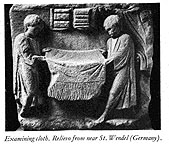
The Roman Dyers
In the earliest times the Romans wore their clothing white or in the natural colour of the material. In course of time, however, some articles of dress became peculiar to certain officials for wear on specified occasions. Such articles were the flammeum, a ceremonial robe of a colour between red and yellow, and worn by priestesses and brides; the purple pallia, worn by priests, and black mourning bands worn in the hair.
The purple trade which soon began to flourish in Rome, and which comprised dyes, dyed wool, and finished fabrics, dealt at first in local, then in Greek products. One of the old Roman families, named after Furius Purpureo, bore as its coat-of-arms the purpura shell-fish. The farther Rome's policy of expansion proceeded, the more centres of international trade became subject to it; for the dye-trade those of Greece were of particular importance. A robe of office of Tyrian purple was first worn by the aedile (legal official) P. Lentulus in 63 B.C. Purple-fishing was carried on in Italy in Ancona, Calabria, Tarentum, Baiae, and in Sicily, and the dye was also imported from Greek beds, Milet, Euboea, Cos, etc.
Under Caesar and Augustus the wearing of the purple was restricted to the holders of certain offices or dignities, but later purple dress became more and more a general fashion. In Rome, in the large cities of the provinces purple dealers and shops conducted by slaves (tavernae cum servis institoribus) catered for the public demand. Numerous inscriptions refer to the purpurarii, and we have evidence of guilds of the purple-dyers. Under the emperors the purple-industry was of great importance. Most of the factories were imperial property, and the emperors' interest in the business was considerable.
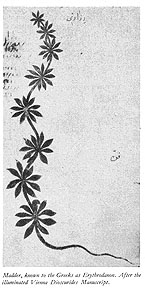 The factories in Greece were in charge of a procurator employed by the emperor. About A.D. 383 a decree was issued declaring the manufacture of the more costly kinds of purple, known as blatta, to be an imperial monopoly. Nobody might manufacture or sell blatta, save only the emperor. It was the privilege of the emperor to wear robes dyed entirely with blatta; private individuals presuming to do so were charged with treason. Actors were forbidden to wear garments interwoven with genuine purple. Nearly every emperor issued special regulations with regard to purple.
The factories in Greece were in charge of a procurator employed by the emperor. About A.D. 383 a decree was issued declaring the manufacture of the more costly kinds of purple, known as blatta, to be an imperial monopoly. Nobody might manufacture or sell blatta, save only the emperor. It was the privilege of the emperor to wear robes dyed entirely with blatta; private individuals presuming to do so were charged with treason. Actors were forbidden to wear garments interwoven with genuine purple. Nearly every emperor issued special regulations with regard to purple.
We now turn to local dye-works which in view of the long duration of the Roman Empire (republic and empire) were in existence for a long space of time. In northern Italy many Romans owned large flocks of sheep, and it is to be assumed that dyeing was also carried on there. In this connection it should be noted that Ligurian wool was by nature reddish in colour. In recognition of their services the purple-dyers of Sybaris in lower Italy were exempted from the payment of taxes. The famous embroidered gown of Hera Lacinia was probably made at Sybaris; the famous shrine of the goddess was also in the South near Croton.
Apulian wools and dyes, especially those of Canusium, were also widely known, Canusian wool was dark in colour. There were two grades, one very fine in texture and lasting, which was not dyed, and another, coarser kind, worn by slaves and soldiers, which was dyed. For this purpose a dye known as purpurissum was used, which was manufactured at Canusium. The manufacture of material from Canusian wool persisted throughout the imperial period.
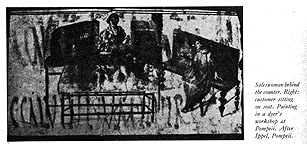 An interesting recipe from the Papyrus Holmiensis may be quoted here: "Boil 10 drachms (roughly 31/3 ozs.) of krimnos (a dye unknown to us, which was soaked in vinegar, perhaps kermes) 32 drachms (11/4 ozs.) of thistles, one chus (3/4 gallon) of water to one mine (ab. 1/2 ozs.) of undressed wool in a lead cauldron. Then put in the wool, test it and it will be Canusinian wool." According to Pliny this wool was of a terracotta colour. Krimnos probably produced a cherry-red colour. In the South there existed already in Grecian times the famous dye-works of Tarentum. The coins of the city bore the purpura shell-fish. As late as the fourth century there was an imperial dye-works there under the charge of a procurator, and another one close by at Satureium. In Sicily the dye-works of Syracuse became famous, and there were others in Sardinia. The dye-works in the Roman province of Spain were probably of different character. Purpura shell-fish were found there in inconsiderable quantities, but dye-roots yielded a rich profit. A famous and popular article of luxury among the Romans were the Carbasian stuffs from Tarraco near the mouth of the Ebro. Equally popular were the fine checked stuffs of Lusitania (the district west of Toledo to the Atlantic coast). Of great antiquity were the dye-works on the Balearic coast; purple dyeing had already been carried on there by the Phoenicians and was still flourishing in the latter days of the Empire. The conquest of Gaul by Caesar brought a new stimulus to the textile crafts of Rome. The Gauls were very skilful dyers. Though not acquainted with the purpura shell-fish, Pliny reports that their vegetable dyes vied with the finest purple, and the products of Gaul formed some of the principal articles of the export trade of the Empire. The thickness and durability of the Gallic textiles were greatly appreciated, and it was for that reason that the Roman middle classes and the army preferred capes and hoods of these materials. Imperial factories were founded in Gaul especially in Narbo and Telo (Toulon), and the demand for Gallic hooded capes persisted to the 5th century A.D. In the East the Romans made use of the ancient Phoenician and Greek dye-works.
An interesting recipe from the Papyrus Holmiensis may be quoted here: "Boil 10 drachms (roughly 31/3 ozs.) of krimnos (a dye unknown to us, which was soaked in vinegar, perhaps kermes) 32 drachms (11/4 ozs.) of thistles, one chus (3/4 gallon) of water to one mine (ab. 1/2 ozs.) of undressed wool in a lead cauldron. Then put in the wool, test it and it will be Canusinian wool." According to Pliny this wool was of a terracotta colour. Krimnos probably produced a cherry-red colour. In the South there existed already in Grecian times the famous dye-works of Tarentum. The coins of the city bore the purpura shell-fish. As late as the fourth century there was an imperial dye-works there under the charge of a procurator, and another one close by at Satureium. In Sicily the dye-works of Syracuse became famous, and there were others in Sardinia. The dye-works in the Roman province of Spain were probably of different character. Purpura shell-fish were found there in inconsiderable quantities, but dye-roots yielded a rich profit. A famous and popular article of luxury among the Romans were the Carbasian stuffs from Tarraco near the mouth of the Ebro. Equally popular were the fine checked stuffs of Lusitania (the district west of Toledo to the Atlantic coast). Of great antiquity were the dye-works on the Balearic coast; purple dyeing had already been carried on there by the Phoenicians and was still flourishing in the latter days of the Empire. The conquest of Gaul by Caesar brought a new stimulus to the textile crafts of Rome. The Gauls were very skilful dyers. Though not acquainted with the purpura shell-fish, Pliny reports that their vegetable dyes vied with the finest purple, and the products of Gaul formed some of the principal articles of the export trade of the Empire. The thickness and durability of the Gallic textiles were greatly appreciated, and it was for that reason that the Roman middle classes and the army preferred capes and hoods of these materials. Imperial factories were founded in Gaul especially in Narbo and Telo (Toulon), and the demand for Gallic hooded capes persisted to the 5th century A.D. In the East the Romans made use of the ancient Phoenician and Greek dye-works.
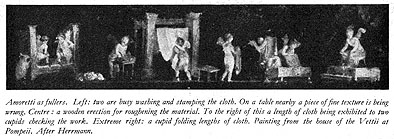
In Pliny's day the only thing that made Tyre famous was its purple dye. In A.D. 300 an imperial factory was set up, which existed for zoo years. It was only as a result of the Mahommedan invasion that it was moved to Byzantium. In Thyatira, known to us through the mention in the Acts of the Apostles XVI, 14, of a woman who dealt in purple, there existed a dyer's guild in Roman times. Illyria and Dalmatia supplied the Romans with their winter clothes. Since Commodus' time (180-192) purple striped Dalmatian clothing was popular. Its influence is still traceable in ecclesiastical dress. Imperial dye-works also existed in Salona and Cissa in Istria.

The purple produced on the north coast of Africa enjoyed good repute. In his Natural History Pliny tells of the dye-works founded by King Juba of Mauretania about 40 B.C. in the Canary Islands. Mauretanian purple remained famous until the 3rd century A.D. Gaetulian purple from the Atlantic coast ranked among the most superior qualities. Syrtis Minor yielded an excellent dye, and until the late period of the Empire the dye-works of the island of Meninx or Girba (modern Djerha, where the textile industry still flourishes) and of Zuchi were justly famous. That dyeing reached a very high stage of development in Egypt need hardly be mentioned here; from that country too, the Romans derived profit. A Berlin papyrus of the early 7th century A.D. mentions a purple factory and dyeing workshop at This, which was in charge of a certain Pachymios of Panopolis. The purple products of Alexandria were regarded as excellent throughout the Empire. Again it is Pliny who describes to us a special process, an Egyptian invention, which was always employed there; patterns of different colours were achieved by tracing them with different kinds of mordants, which resulted in different colours, even though the material was immersed in one dye only. In Syria there were purple factories at Sarepta, Caesarea, Neapolis, and Lydda.
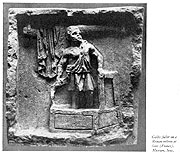
Even in the days of King Numa there were dyer's guilds in Rome. There, too, as in the Middle Ages we find a division of labour. There were not only tinctores (dippers of Greece), but cerinarii - dyers of wax-yellow, violarii = violet (or blue) dyers, fiammarii = red-dyers, and the crocotarii = saffron-dyers, the spadicarii - brown-dyers, and finally the purpurarii = purple-dyers. Dyes and technique of the Romans probably were similar to those of the Greeks, though we have no records of this period. The famous edict of Diocletian (284-305 A.D.) gives a list of the various kinds of purple together with prices according to which the stuffs were rated, so much per pound of wool. It will be remembered that Alexander the Great found at Susa stuffs weighing (not costing) 5000 talents. 1 lb. of the most expensive material cost 150000 denarii, about us (kermes), and four kinds of Hysgin wool dyed with orseille. It may be mentioned that Kermes dyeing was carried on not only at Nicea, but in Galatia, Pisidia, Cilicia, Spain, Africa and Sardinia. We close this sketch with the description of an illustration showing the entrance to a dyer's workshop found at Pompeii (cf. p. 292). Under a tent-like roof still covered with the ancient tiles, the entrance was excavated. To the left we see Mercury, the god of commerce hastening from his temple with a bag of money: "salve lucrum" (Welcome, profit!). To the right of the door is Venus Pompeiana, the patroness of the dyers, standing in a chariot drawn by four elephants. Several election slogans found painted on the walls of houses in the city are the work of dyers, e.g.: Postumium Proculum aedilem offectores rogant = the dyers propose Postumus for election, as aedile. Such Roman dyers' guilds are found also at Hierapolis in Phrygia and at Thessalonice in Macedonia. Furthermore, dye-shops have been dug out of the lava and rubble of Pompeii, and we may form an impression of dye-workshops from excavations of two other buildings.
One lies in the Stabian Street in a pillared court accessible from the street. Nine lead cauldrons, under which fires were built, as well as numerous well-preserved bottles containing dyes place the purpose of the building beyond all doubt. In the doorway there was a painting-since unfortunately destroyedwhich showed a man holding freshly-dyed cloth on a pole. The other workshop was identified by means of similar fittings. A meetinghall of the dyers' guild has also been discovered, and it is hoped that the third workshop, the entrance of which is shown on p. 292, will be completely uncovered.
Thus Pompeii proves that in some Roman towns there were several flourishing dyeworks, and that the craft was plied with great energy and skill.
Dress and Dress Materials in Greece and Rome
by G. A. Faber
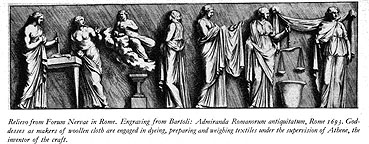
In view of the enormous amount of written and pictorial evidence at our disposal it cannot be said that the history of Greek and Roman fashions in dress has in any way received exhaustive treatment. Like ourselves, the Ancients were subjected to the whims of fashion, though changes then were less rapid than in our day. From the Cretan-Mycenaean period down to the days of the Emperors we are able to trace the perpetual change in dress by means of a wealth of statuary, sculpture, painting, etc. The perfection attained by the Greeks and Romans in the manufacture of textiles, in spite of their comparatively primitive technical equipment, is scarcely out-done by present-day standards.
The first raw material used for spinning and weaving was wool: our knowledge of sheepbreeding, of the estimation of wool according to fineness, density, length, and colour goes very far back. Wool, improved by breeding, and of exceptionally high quality, was imported from Miletus, Attica, Megaris, and Tarentum. To achieve a finer quality of wool, the sheep were covered with skins. It was probably this wool which yielded the famous transparent stuffs. Then there was coarse wool imported into Rome from Gaul. The most valuable wool was pure white, lana alba, then came Canusinian wool, which was brown, the reddish variety from Asia Minor, the grey-brown quality known as impluviatus, and coracinus which was black. The treatment of wool by spinning and weaving was highly developed; we must, however, pass over this item, as it would entail the writing of a treatise.
Only coarse stuffs, cloaks and rugs for the army, and felt slippers were made from goats' hair. Flax, known to the Greeks and Romans as linon or linum respectively, was chiefly cultivated in Egypt, where people wore linen. Fine linen was called byssus; the yellow byssus of Elis being the most costly. Little flax was grown in Greece, but a large quantity was imported. The Romans did not begin to wear linen until comparatively late; towards the end of the Republic a linen garment for outdoor wear became popular for women. In the first century B.C. the flax and linen production of Saetabis (Jativa) in Spain was highly esteemed in Rome. The poet Catullus (ab. 87-54 B.C.) boasts on more than one occasion of the superior quality of his linen handkerchiefs, whose value may be judged from the fact that it was customary to exchange them as souvenirs. In Imperial Rome an extravagant display was made with articles of linen.
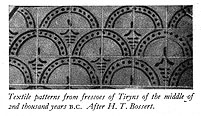
When cotton is mentioned, it may be assumed that Indian products are referred to, with which the Greeks became acquainted through the wars of Alexander the Great, though famous cotton-goods factories are said to have existed on the island of Malta in Roman days. It may be mentioned that Indian muslin was considered particularly suited for dyeing; indigo, for instance, when used for dyeing linen, turned very dark, while retaining its brilliance on cotton.
The fibre of mallow, which is related to the cotton plant, provided a material woven on the banks of the Indus and brought by merchants (molochinarii) to Rome as early as the 3rd century B.C.
The historian Herodotus (450 B.C.) reports that the Thracians wove clothing of hemp, but the Greeks and Romans do not seem to have worn this material.
As regards silk there was a distinction between vestes coae, i.e. materials from the island of Cos, where silk-worms had been imported, bombycinae and sericae. Vestes coae were fashionable in Augustus' day, and the women in the writings of Propertius and other lyric poets are frequently described as wearing garments of Cos. They were quite transparent, of purple wrought with gold, and very costly. Aristotle (384-322 B.C.) was already acquainted with the silk production of Cos. Bombycinae came from Assyria, from a wild silk-worm, the cocoons of which had to be scraped instead of the usual procedure of unwinding.

Sericae came from China. Cleopatra (1st century B.C.) wore a robe woven in China, dyed at Sidon (cf. Ciba Review No. 4), and embroidered in Egypt. In the West the sericae were mixed with linen or cotton to form a kind of half-silk, and worn by men as well as women in Rome. The first man to wear robes of pure silk in Rome was the Emperor Elagabal (A. D. 218-222), who was at the same time High Priest of the Assyrian Sun God, and who surrounded himself with every kind of Oriental luxury.
The value of silk was equal to that of gold. In A.D. 552 the Emperor Justinian, who did a great deal to further trade and commerce, had silk-worms brought to Byzantium, and made the silk trade an Imperial monopoly.
The following rarer materials may be mentioned in passing: vestimenta acanthina were made from the fleecy surface of the leaves of acanthion, a species of thistle; there were also stuffs woven from the hair of beavers, rabbits, and camels, and even from fibrous threads yielded by a shell-fish known as pinna, which is native to the Mediterranean. Pinna was used for this purpose in Tarentum in comparatively recent times, the museum at Gotha possesses a glove made of such material. Asbestos was also used in the manufacture of stuffs, especially for the sake of its fire-resisting qualities.
Following the Oriental example, both woollen and silk cloths were interwoven with gold thread. The use of materials made entirely of gold thread was a luxury common in Imperial Rome. Heavy gold cloth has been found in the course of excavations at Herculaneum, but also in Etruscan graves.
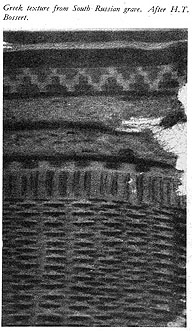
The patterns of ancient textiles are familiar to us from paintings, sculpture, etc., which have come down to us. Not only ornamental patterns of every kind, but elaborate designs from flora and fauna, from legend and fable, even landscapes and historical scenes decorated the materials. In the Iliad Helena is described as embroidering a robe with scenes from the struggle between Trojans and Greeks. The robe worn by Hera when tempting Zeus, is described-also in the Iliad-as being richly embroidered.
Homeric dress
The principal article of men's dress as described by Homer was the chiton, a shirt or smock varying in length. The chiton worn under armour was short, that of the ordinary citizens reached approximately to the knee. Long chitons reached to the ankles, and the Ionians, who of all the Greek tribes first attained to a refined form of civilization are described as wearing garments which swept the ground. The chiton generally had a patterned hem. Woollen cloaks (chlaina) served as a protection against the cold. Princes wore the pharos, a loose cloak of fine linen.
The peplos and the pharos formed the everyday dress for women, the pharos only for women of rank. The peplos consisted of a large rectangular piece of material, fastened on the shoulders with elaborately wrought brooches. Waist and bust were emphasized by a tightly drawn girdle. The arms and feet were bare, and were covered for outdoor wear by the pharos, which was also worn with a belt. Head, shoulders, and back were covered by the calymma, a veil of fine linen cloth.
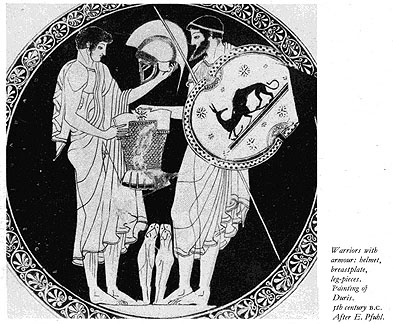
Greek dress after the Persian Wars
In the period of quiet development which followed the Persian Wars a form of dress developed, which on the whole was maintained throughout the classical period. The long chiton disappeared, being now only worn by priests, actors and in chariot-races. The place of the wide arm-holes peculiar to the chiton was taken by sleeves which as a rule covered only the upper arm. A square cloak, the himation, enveloped the body, leaving only the right shoulder bare, the left arm remaining covered. The himation was worn in picturesque folds, but it was considered vulgar to arrange it in a way different from that described. This was the urban dress of the free man; slaves, workmen, and peasants wore the chiton or skins. Instead of the himation, soldiers wore the Thessalian or Macedonian chlamys, a short cloak worn in various ways, now covering the chest, now leaving it bare. During the warm season of the year the chlanis, a mantle of fine Milesian wool was worn.
In the classic period the beard was worn short, and the hair tightly rolled. Boys wore their hair long. For travelling men wore a broad-brimmed hat, known as petasos; when the weather was bad or the sun hot, a leather cap was worn. For old men the pilos, a felt hat, was customary. On the feet sandals were generally worn, shoes but rarely. High laced boots were common for travelling, hunting, and riding. Actors on the stage wore high Lydian boots as cothurns. In cold weather felt or fur served to protect the legs; the peasants wore leather gaiters.
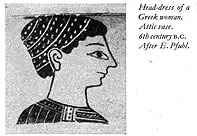
Women's dress was more complicated. It would go too far to trace the differences between Doric, Ionic, and Attic dress. Vase paintings and sculptures show an absolutely overwhelming variety of dress. These are the essential features: women wore the peplos in many different ways, from the formal cloak to the airy wrap, either loose or belted. A brooch or clasp fastened it over the shoulders. As a rule a cape was also worn, which was attached to either shoulder. Apart from the woollen peplos, the linen chiton remained in use. The wide, sleeved chiton was the garment of women of rank. When mistress and servant are depicted together on relievoes, the mistress wears the chiton with buttoned sleeves, the servant the peplos.
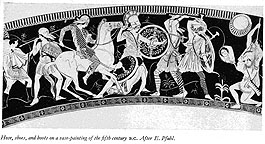
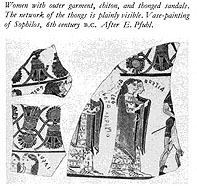
Sandals with ornate straps, shoes or boots were worn on the feet. The hair was parted in the centre, bound with a ribbon and dressed with ribbons, combs, nets, veils, etc. Only unmarried women wore bonnets, which on marriage were sacrificed to the nymphs. The great variety of jewelry, some of it of superb craftsmanship, worn by women for the enhancement of their charms, must be passed over here, constituting as it does a special field of ancient culture.
Roman dress
Roman dress was very strongly influenced by the Etruscans, who from 800-400 B.C. were predominant in Italy. The dress of the men consisted of an under-garment, the tunica, and a mantle, the toga (see title-page). The tunica was a kind of shirt, consisting of a front and back piece sewn together. It was either sleeveless or had short sleeves. The long-sleeved tunica was considered effeminate, and did not become popular till the time of the Empire. The tunica was belted about the waist, and reached to the knees. When enjoying his ease at home, the wearer removed his belt, and allowed the folds of the tunica to fall to the ground like a loose gown.
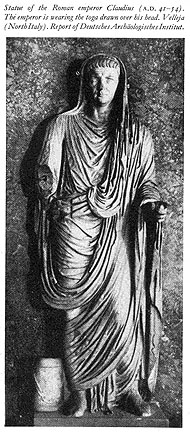
The toga
was conferred on the free man and on him only in a solemn act of ceremony when he reached man's estate. It was the mark of his birth-right as a Roman. No slave, outlaw, or stranger might wear it. Whereas the Greek mantle was square, the shape of the toga was elliptic, the proper length of the cloth being three times the height of the wearer's shoulder from the ground. Great care was taken in draping the toga in the prescribed folds. In the early days the toga did not form a sinus or puff, and it covered the right arm. Later a toga was worn which also covered the right arm, but which had a sinus formed by the upper and lower folds of the material. The toga was worn in peace and war. In battle it was worn with the "cinctus gabinus", the end normally flung over the left shoulder being wrapped round the body to form a girdle. This left both arms free, and prevented the toga from slipping. As a badge of office or rank, the toga bore a purple hem. The toga praetexta (the braided toga) was the dress of the curule officers (aedile, praetor, consul) and of some priests. The senators wore the tunica laticlavia (with a broad stripe), knights the tunica angustielavia (narrow stripe). The clavus was a purple stripe either sewn or woven to the tunica, running in two parallels down from the neck. On ceremonious occasions the toga was drawn over the head. Those not entitled to the toga wore the paenula, which became above all the dress of the muleteers, slaves, and litter-bearers. Hats were the same as in Greece.
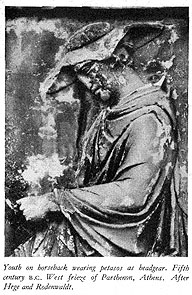
Women's dress was very much dependent on fashion. The dress of the Roman matron (habitus matronalis) differed from that of girls, slaves, courtesans, strangers, and freed women. Common to all was the fascia pectoralis, or breast-band, a loose undergarment, the subucula, and a tunica interior, worn in the house. The free Roman woman had the privilege of wearing a stola over the under garment, this corresponded to the privilege of the toga. This custom became prevalent during the second Punic War (218-201 B.C.), and took the place of the toga, which before then was worn by married women. At the time of the Empire, a woman entitled to wear this badge of distinction was known as femina stolata. In its cut the stola resembled the tunica, reaching to the ground and leaving the fore-arms bare. The stola was taken in at the waist by a belt, the hem was decorated with a hand, the instita. A mantle known as the palla completed the attire. There were two ways of wearing it. It was a square piece of cloth, which women entitled to the stola allowed to fall over the left shoulder to about one third of its length, the remainder covering the back, and passing over the right shoulder or under the right arm in such a manner as to reveal the short sleeve of the stola, thus making it possible to recognize a matron at a glance. On ceremonious occasions the palla was drawn over the head exactly like the stola. Women who did not wear the stola wore the palla as a "tunicopallium", that is to say, it was worn as a combination of a robe and a cloak, not unlike the Greek peplos. One half covered the back, the other was drawn over the breast, two clasps (fibulae) on the shoulders held the two halves together. The dignity attached to a palla worn by a matron equalled that of the toga. Unlike the matron, girls, slaves, freed women, and courtesans wore no vitta. The vitta was a closefitting high bonnet fastened above the forehead with a pleated band. Greek and Roman dress are typical of the two nations, and from the study of ancient pictorial art we may see that the Greek dress is imbued with the precious charm of that gifted nation, and the love of beauty which has proved irresistible. On the other hand the stern, austere, and rigid spirit of its citizens, and the differences of class, rank, and office are consciously stressed in the differences of Roman dress.
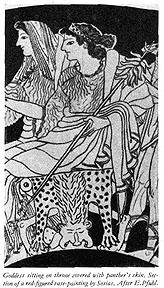
Greek and Roman Tanners
by G. A. Faber
In Homer's day tanning was partly a domestic occupation carried on by the peasantry, and partly a craft, which was, however, not yet independent, but practised by the leatherworking trades. The first Greek leather-worker of whom we have evidence was one Tychios of Boeotia, a native of Hyle, described by Homer as the maker of the famous shield of Ajax, and by Pliny as the inventor of tanning. Polybos, who supplied balls of red leather to the Phaeacians, is mentioned in the Odyssey, and Homer is familiar with many kinds of leather goods; only the beggar is content to have an untanned hide for a couch. Homer's heroes have beds made of the skins of sheep, oxen, or bisons, Aeneas slept on a bear-skin. Sheep-skins served as blankets, and Pliny mentions a rug made of moleskins, which he saw on a journey to Greece.
Skins and dressed hides served as coverings for couches and chairs (see illustration on this page). A magic power was ascribed to some of these skins: The priests slept on skins when they desired dream oracles, timid folk slept on deer-skins as a protection against snakes, and in Rome bride and bridegroom sat on two chairs connected with each other, on which a sheep-skin was spread. Homer's men wore skin clothing in battle and at work, and even in historic times such clothing was common in the rural districts of Greece, in Euboea, Phocaea, and among the Locrians. For this purpose the skins of the ox, the lion, and the bear were used. It is of interest to note that Homer also mentions leather helmets. A primitive form of tawing is described in the 17th book of the Iliad (389ff.): The ox hide, which is soaked in fat, is pulled to and fro by men standing in a circle, thus stretching the skin and causing the fat to penetrate into the pores.
It was not until a later period that tanning became an independent craft, though it must be assumed that where work was carried on on a large scale tanning and shoe-making were generally connected. In Greece the trade of the tanner, the Byrseus, Byrsodepses, or Skytodepses, as he was called, was generally on a fairly considerable scale and very lucrative. In spite of the large number of cattle bred in the country, hides were imported from the trade-centres on the Black-Sea, which were supplied by the nomads of the interior; a particularly large supply came from Cyrene in North Africa. From elsewhere, especially from Pontus, came entire carcasses, specially treated to prevent putrefaction. In Athens Anytos became a wealthy man through his ownership of a large tanning-yard, and was one of the best-known politicians of Athens in his day (end of the 5th century B.C.), belonging to the circle of Socrates.
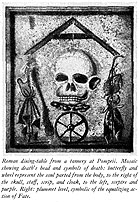
After a violent quarrel with Socrates in 399 B.C., he brought that indictment against him which ultimately led to the philosopher's condemnation and death. Another Athenian statesman, Cleon, who died in 422 B.C., was the proprietor of a large tannery. It was situated in the district of Cydathen, to the north-east of the Acropolis on the river Eridanos. According to the evidence of inscriptions there must have been several tanning-yards in this somewhat remote part of the city, which was assigned to the tanners because of the evil smells connected with their trade. Tanning was regarded as a degrading occupation, owing to the contact with the dead animals. Aristophanes'(ab.446 385 B.c.) comedy "The Knights" contains a number of allusions to tanning. This political play is directed against the military and financial policy of Cleon.
The first of the four steps in the process of tanning, soaking the hides, we may take for granted to have been the same as practised everywhere.
To clean the flesh-side, the hide was stretched on a bench, as on the currier's beam nowadays, and scraped. Aristophanes describes in detail, how the tanners pegged the hides to the ground, and how they plucked the hair from the skins. Of the preliminary stages which precede the scraping we are informed by Pliny. To facilitate the process of sweating or unhairing the hides, the Greeks made use of mulberry leaves, urine, and the fruit of the bryony (bryonia dioeca). Of a process which corresponds to swelling the hides we know nothing.
As for the actual curing of hides, the Ancients were familiar with tanning, tawing, and chamois dressing. For tanning the following vegetable substances were used: bark of pine and alder, the skins of pomegranates, sumac leaves, gall-nuts, and acorn-cups. From the Egyptians the Greeks also learnt to use the fruit of mimosa nilotica, the Egyptian acacia. There is no doubt that the soft leather known to the Romans as aluta was so called because of the alum used in curing it, and that the name was used to describe tawed leather which was very soft and pliable. The use of oil in leather-dressing is also well established. The substances used for dyeing leather were the bark of the lotus tree, madder, kermes, blue-stone, and others not specifically mentioned.
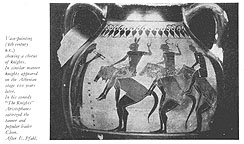
The Roman tanners were known as coriarii, and we find them mentioned in several inscriptions. There was also a word pellio (from pellis - skin), meaning furrier, dealer in furs, or tanner, and which was from a very early period used as a designation of these crafts. The tanners formed the sixth guild of the eight founded by King Numa Pompilius, upon which the industries of a later age were built up. There was a corpus coriariorum magnariorum, solatariorum, in other words, a tanner's district, situated beyond the Tiber in the XIV. municipal region. The pelliones too, were united in guilds in Imperial Rome. They had their hall at Ostia, the port of Rome, which is significant of their importance. Together with the other crafts, the pelhones were ordered by the Emperor Alexander Severus (A.D. 222-235) to pay certain taxes, but a century later they were again freed from all taxes and tributes. According to a remarkable statement of Firmicus Maternus it was believed that children born under a constellation of sun or moon with Mercury or Mars should become pelliones.
We have detailed knowledge of the skins used in Rome. Whereas Homer speaks ofleather made from the skins of ox, goat, and weasel, the Edict of Diocletian (A.D. 284-305) a list of goods with their maximum prices, quotes a large number of different kinds of leather. The Romans, who required enormous quantities of leather, drew their supplies chiefly from Sicily, Asia Minor (fine Babylonian, Parthian, Trallian, and Phoenician leathers), Illyria, Germany, Britain, Russia, and India. In the edict the various kinds of neat's leather are duly distinguished, as well as other skins from the cheapest to the costliest, those of: goats, sheep, lambs, hyaenas, deer, wild sheep, wolves, martens, beavers, bears, jackals, seals, leopards, lions.
|
A good impression of a tannery of ancient Rome is gained from one excavated at Pompeii. It was discovered in 1873 near the Stabian Gate close to the citywall, and built into old dwellinghouses. A large room contains all the fittings typical of a tanner's workshop. The former atrium (the ball of the Roman house) had been converted into a workshop, and supported by a central pillar. The room measures roughly z8ft. x oft., part of which space is partitioned off by a low wall, and contains fifteen round pits, varying between and 5ft in diameter.
They are about ft. deep, and lined with plaster. The walls show two holes which served to facilitate climbing in and out. The pits are arranged in pairs on either side of a long trough about zo ins, deep, which appears at one time to have been lined with wood. Along these three troughs and between each pair of pits clay vessels have been let into the floor, a seventh is near the southeast corner close to one of the pits. A narrow cylindrical canal runs vertically downwards between each clay vessel and the trough, into which it finally opens. The canal, which corresponds exactly to the depth of the pits, probably contained clay piping, of which, however, no trace remains. In the clay vessels remnants of some substance were found, but unfortunately never analysed. The pits and troughs served to bring the skins into contact with the tanning bodies, the former being used for tanning in the proper sense of the word, the latter for tawing. The tanning agents were contained in the clay vessels, and were conducted into the pits by means of the pipes. Another room which formed part of the workshop, lay in a porticus opening on to the garden, and probably served for the preparation of the tannage. Part of the liquid ran from a large basin through two openings into a low trough, another part proceeded through a gutter running along the wall, from where it ran through three branch channels into large clay vessels. The merit of having reconstructed the procedure belongs to Mau, the authority on Pompeii.
| 
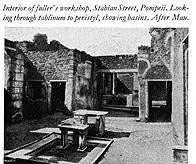
|
Historical Gleanings
The Fullonica of Pompeii
In a large building at Pompeii a marble statue of a woman was found, which bore the inscription "To Eumachia, priestess of the city, from the guild of fullers". The fullers' guilds were found all over Italy. They were among the tradesmen's companies founded by King Numa. Every Roman guild had its patron deity; that of the fullers being Minerva, whose feast was celebrated on March 19th, and their badge was the owl, the bird of Athene. Among the Ancients, the fuller's trade was not only concerned with the treatment of new stuffs; cleaning or washing clothes was also done by them. For this reason they had always plenty to do, and were to be found even in the smallest towns. Nicias of Megara was considered to be the inventor of fulling. The trade was also organised in guilds in Greece. Among the Romans, who learned the craft from the Greeks, fulling was an important activity which is frequently mentioned, and was often a source of considerable wealth. Thus we hear of a fuller of Mutina, who was rich enough to organise public games for the amusement of his fellow-citizens.
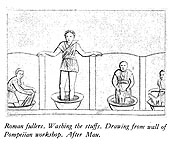
Several ancient fullers' workshops (fullonicac) have been excavated at Pompeii. In the largest of these fullonicae, situated in the street of Mercury, a series of paintings illustrating the craft were found (sec illustr.). A frieze found in the house of the Vcttii shows amoretti working as fullers (see illusrr. p. 292). Another workshop was in the Stabian Street, and belonged to an influential banker named Caccilius Jucundus.
In the peristyl of the largest fullonica four large vats for water are so connected with each other that the water could run from one to the other. Close by are six adjoining cells for the tubs in which the material was fulled or pounded. Finally there is a large vaulted room with a large water-vat of masonry and a stone table on which the clothes were scoured. This room also contained a heap of fuller's earth. Other rooms were probably used for drying, or contained a press such as is shown in the painting. In the small fullonica, Stabian Street there are three large water-basins side by side, in which the stuffs were soaked, and into which water flowed from a tap. To the left is a large pillared room, to which one mounted several steps, at either are niches where the material was scoured and pounded in water vats. The site of the press has also been uncovered. In passing it may be mentioned that a Roman fuller's workshop has been dug up at Pola in Dalmatia, which is worthy of note by reason of the fact that the fittings for cleaning the cloths by stamping or kneading them with the feet have been very well preserved. There are three conical stone vessels fitted with lids. The largest is slightly less than a yard deep and about 42 ins. in diameter across the top. In the same room there is a stone slab, about 4 ft. X so ft. on which materials were spread and beaten with a species of mallet.
Fulling consisted in stamping or pounding the materials in fulling troughs or pits. The aim was to purify the wool of fat and other substances, and to render the tecture closer by process of felting. The fulling pits had to be near a spring or well; or near the public aqueducts, for which privilege the fullers paid a yearly tax to the State. The Egyptian hieroglyph for fuller is two legs standing in water; this fact and the paintings of Pompeii show that the materials, both new cloths and laundry, were pounded by stamping them with the feet. Soap being unknown, nitron was added to the water, a substance identical with soda. Clothes cleaned by the fullers were therefore known to the Greeks as nitrumena. Human and animal urine was also frequently used. Urine which had stood for a week or two formed a kind of liquid soap with the fat contained in the textiles. The Roman fullers gleaned their supply of urine from large earthen jars which were placed at quiet corners for the use of passers-by. Finally creta fullonia, fat-absorbing fuller's earth, was used; a species of clay found on the island of Kimolos, in Umbria, Lemnos, and Samos. A cheaper kind, only suitable for white materials, as it adversely affected dyes, was imported from Sardinia. In Greece gypsum was also used. After washing, the stuffs were beaten with sticks or switches, which furthered the process of felting, that is, of binding the individual threads to form one mass. After drying, the cloth was roughened, and loose ends of thread pulled. To this day the head of the fuller's thistle (dipsacus fullonum) is used for that purpose in some districts. The Ancients attached several bunches of spina fullonia, a thorny plant, to a metal instrument, the aena, or used the skin of a hedgehog to roughen the textiles. The flakes of wool combed out in this way served as padding for cushions etc., and were comparatively expensive, being beyond the means of the poorer people.
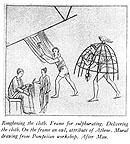
The next step was the sulphuration of the cloth. First, it was spread over a semispheroid frame (see illustr.) under which sulphur was burnt. Thereupon the materials were rubbed with fuller's earth, to prevent them from becoming easily soiled and to brighten faded colours. Brushing is not mentioned in the Greek and Latin writings, but it seems unlikely that this necessary procedure was dispensed with, before the cloth was hung up and cropped with shears to remove all small threads of wool. If fleecy texture was desired, the material was cropped on one side only. The former kind was known as psila, the latter amphimalla. At the beginning of the Imperial period, fleecy fabrics were made at Padua in large quantities.
The final stage of the proceedings was the pressing of the stuff in linen-presses (pressorium). Before pressing, the fuller filled his mouth with water, to sprinkle the cloths. The hand-screw of the press was called peristrophis. The fuller's work was done, when the press was unscrewed (solvere prela) and the materials removed.
G. A. F.
Heraclius
Whoever may have occasion to study dyeing among the Ancients, cannot afford to pass over a remarkable Latin book known as: "The Three Books of Heraclius, the eminently Wise Man, concerning the Dyes and Arts of the Romans." It is a work of the 9th or 10th century, and is known to us from two manuscripts, one of which was discovered in the library of Trinity College, Cambridge, in 178s, the other being in the National Library in Paris. The name Heraclius is a medieval fiction, being simply the personification of Heraclius, the name of the touchstone for gold and precious stones. It reminds one of the tale, in which the Roman king, Phocas, bought a slave-boy named Heraclius who knew the powers of all precious stones. The book, the author of which is unknown to us, was presumably written in Rome, and records details of arts and crafts, as practised in Byzantium (Constantinople). It must be remembered that in the 10th century hosts of artists and craftsmen fled to Rome from Byzantium. Our "Heraclius" may have been written by one of them. It contains primarily recipes for the preparation of artists' paints, but also discusses vegetable dyes for textiles etc. An instruction in the dyeing of leather may be quoted here: "Take clean white Cordovan leather, and wash the scraped hair-side with alum. Then heat a mixture of madder and wine over the fire in a brass cauldron, but only so far "that one can still dip one's finger in it". Then immerse the leather in the liquid, moving it to and fro until it has assumed a red colour. Finally spread the leather on a level slab and smooth it with a boxen roller. Then rub the entire skin with fat and let it dry." It is well known that the Ancients were masters in the dyeing of leather. Purple, scarlet, golden, and black shoes are frequently mentioned. Apart from tanning agents, which in themselves contain dye, the materials most frequently used for dyeing leather, were the bark of the lotus tree (diospyros lotos L.) which dyed yellow, madder, scarlet, ivy, and especially bluestone or copper vitriol. Heraclius also mentions ivy. "The strength of ivy is well suited to our purpose. Its leaves were considered by the Ancients a token of great honour, they formed the crown of the poet. In early spring, when all is bursting with fresh sap, the branches should be tapped with an awl in several places. The juice which is then discharged turns scarlet or blood red when boiled. From this the rose-coloured Parthia-dye is made, which is used for colouring sheep and goat-skins." The name Parrhia-dye is connected with a famous article of commerce in Rome: the skins imported from Parthia were dyed red, and were always costly. The purple shoes of the Roman emperors were of Parthian leather. Manufacturers and merchants trading with this leather were known as parthiearii. Bluestone was obtained by boiling water containing copper vitriol. After boiling the liquid was placed in wooden vats, into which stones were suspended from cords. The vitriol was deposited on these stones in blue grape-like masses. The stones required a month to dry properly. The blue-stone thus obtained was dissolved again for dyeing leather, it combines chemically with the tannage contained in the leather, and it is this combination which produces the black dye.
G. A. F.
Shades of Colour in Classical Antiquity
The Ancients possessed a sense of beauty schooled from a very early date by works of art, and by the natural beauties of the landscape around them. Glaring colours were abhorrent to them, but the colourful southern scene roused in them the love of colour, and the desire to wear colours themselves. Though the clothing of everyday was plain, white or dark, there were many opportunities for wearing festive, colourful dress. It was Semper who in his book on "Style" defined the classical conception of colour as opposed to that of our own day. It was the aim of the ancient dyers to harmonize colours and material in such a way as to make them seem as one, and never the former merely superimposed on the latter. Furthermore, the ancient craftsmen used "really natural colours, each akin to the other as a colour of Nature herself, and never being, or trying to be, merely an abstraction of the idea of colour". Thus it is natural that the names of the different colours are not mere abstractions; a simple red, yellow, blue, green, etc., is scarcely to be found in the classical languages. Some analogy to Nature always furnishes the name. No Greek would think of calling a garment merely green; he would compare it with the world around him, and describe it as "frog-green", or "olive-green", or "apple-green". "The sea-green of the rolling flood" is an expression used to describe the folds of a green drapery. A certain kind of clothing was known as vestes calthulae, after a yellow wild-flower. One party of competitors in the games was distinguished by its vestes prasinae, its leek-green cloaks. A famous passage of Ovid's "Art of Love" advises women on the colours they should choose for their clothing, in order to attract men: the pure blue of the cloudless sky, the natural colour of wool, the yellow of saffron, the green of the Papbian myrtle, the darker green of the oak, the grey of the crane, the amethyst, the almond-tree, and the cherry "shall give name and colour to the wool, and the white rose shall find itself surpassed". The reader may also be referred to the colour-scale of ancient purple given by Lacaze-Durhiers and Dedekind (Beitrage zur Purpurkunde, pp. 47ff.), as well as to the advice of Semper, to study a collection of sea-shells, with their colours passing from scarlet through indigo to blue, from blue through sea-green to yellow, from yellow of all shades to pure white; then he will know what the ancients meant by purple colours.
G. A. F.
Greek and Roman Superstitions Connected with the Colour Red
The Greeks and Romans regarded red as a symbol of blood, and ascribed magic powers to it. Purple threads were used in Greek love-charms, and amulets of red thread were very popular in both Greece and Rome. The magic spinning-top mentioned by Greek and Roman poets, was red, probably covered with red wool; it was used to recover lost love. The dream-
book of Artemidon1s (An. 2nd century) which was translated by the humanist Philip Melanchthon, tells us that wreaths of red wool signify enchantment. On ceremonious occasions the hearth was draped in red, and the Vestal Virgins, the priestesses of the Roman deity of the hearth, wore a head-dress of red woollen threads in the form of a diadem. Here the red colour served to ward off evil spirits. The red gown of a Greek bride is also to be explained as a protective charm. It was part of the Roman wedding ceremony to wrap the bride in the flammeum, the red wedding-wrap. On the eve of her wedding the Roman bride wore the reticulum, a red hair-net. Early Christian nuns wore purple veils, and on one of the paintings in the catacombs we see a virgin being invested with the purple veil (cf. Wilperr, Die Malerei der Katakomben Roms, plate 49). The priest of Zeus wore a red head-dress, the priests of Heracles and the priests of Cybele wore red vestments. The Roman priest, the flamen, wore a purple praetexta. Even the animals destined for sacrifice, with the exception of sheep, were decorated with red woollen ribbons. The purple garb worn at the Mysteries by the priests and by those initiated into the secret rites, served to protect the wearer against hostile powers. Similar beliefs also influenced medical practice: Compresses of purple wool were prescribed for illnesses of the stomach, stones wrapped in red cloth were a cure for head-aches. After bleeding a patient, purple wool was placed upon the wound; ear-ache was cured by putting red wool into the ear. The fact that Roman children wore a purple-trimmed outer garment is also to be regarded in the light of a measure to protect the defenceless child.
G. A. F.
Dyeing the Living Wool
The Egyptians were, as we know, able to dye the
wool on the living sheep a rich purple. In his book
"Der Stil" (On Style), Semper leaves the question
undecided whether the animals were placed on a special
diet to further the process. It may be mentioned that
the great Roman poet Virgil (70-19 a. c.), the author
of the "Aeneid" and the "Georgica" (poem on rural
life), states that sandia garanicia, the madder-plant,
dyes the animal red which eats it, and fine red robes
were known as sandykes.
G. A. F.
Gaius Plinius Secundus
Though Pliny was in no way directly concerned with either the textile or tanning trades, we owe our knowledge of the history of these crafts to such a large extent to his pen that a sketch of his life may not be without interest.
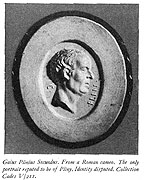
Gaius Pliniua Secundus born An. 23 at Novum Comum (Como), was the son of a noble house. He was brought to Rome at an early age and educated there. His career as a public servant, which led him to the highest offices of the financial administration, also brought him into close, almost friendly relations to the Emperors Vespasian and Titus. All his life he enjoyed the esteem of the influential political circles. He also served the state in a military capacity; as a cavalry officer in various provinces, particularly in Germany, and later as a naval officer. He was acting in the latter capacity when he was killed in the eruption of the Vesuvius in A. D. 79.
In spite of his many professional duties, Pliny's work in the field of history and science was such as to cause him to be hailed as the foremost scholar of his age. His nephew and adopted son Gaius Plinius Caecilius Secundus, Pliny the Younger, tells in two of his letters of his uncle's work and mode of living, and of his death. From him we learn that Pliny wrote a book on horsereanship, two books on the life of Pomponius Secundus, a general in the Roman army and a tragic writer, whose friend he was. Furthermore, Pliny wrote a history of the Teutonic wars in twenty books, an undertaking to which he was induced by a dream, while he was himself serving in the field. Drusus, who had fought in Germany together with his stepbrother Tiberius, and who had been killed there, appeared to him, and begged him to redeem his name from oblivion. Pliny also wrote a manual of oratory, a book on uncommon words and phrases, a history covering several decades of the Empire, and finally his famous natural history.
This enormous volume of work would not have been possible, had Pliny not adapted his whole way of life accordingly. Excepting a few brief hours of sleep, not a minute of the day passed, which was not turned to account. When dining, bathing, or resting, he had a slave read to him, and made notes of what he considered important. He left an enormous number of such notes at his death. He never went on foot, but rode in a litter, which enabled him to occupy his time the better. When travelling he was always accompanied by a short-hand writer with writing-materials at hand to take down notes, and in winter armed with gloves, lest the cold should keep him from writing.
The other letter of the younger Pliny, written at the request of his friend Tacitus as material for the latter's work on history, describes his uncle's death in the eruption of Vesuvius in A. D. 79. The latter is famous as the first description of a volcanic eruption. The elder Pliny was in command of the fleet stationed at Misenum. On becoming aware of the approaching outbreak, he resolved to proceed in a small boat to the scene of immediate danger to satisfy his scientific, curiosity, and invited his nephew to accompany him, who excused himself with the pressing urge to continue his studies. When a message from the troops at Rectina on the slopes of Vesuvius arrived, pleading for rescue, which was only possible by sea, Pliny had galleys launched, and went on board himself. During the voyage he stood in the bows dictating his observations to a slave. On his arrival at Rectina he calmed the fears of those about him by dining, bathing, and sleeping as usual. The ground gradually became covered with ashes and cinders, and it was feared that it might become impassable. Pliny was called, and decided to go to the shore, to see whether the sea had grown calmer, but it was as wild as ever, and no boat could be launched. Soon flames appeared on the mountain, preceded by a strong smell of sulphur. Supported by two slaves Pliny struggled to withstand the weakness which had seized him, but almost at once he fell back dead. The writer of the letter believed "that the thick smoke had obstructed his breathing and closed his stomach which was always very weak".
The work which made Pliny famous was his "Natoralis historia". It was compiled from about 2000 books by 100 authors, and comprised 36 books. In the dedication to the Emperor Titus he said himself that no Roman had ever attempted anything like it, and that no single Greek author ever covered so much ground. The history began with a description of the universe and the earth, of man, of animals, and plants. Then follows a detailed description of animal and vegetable medicines and dyes, of the medical science and of dyeing, and finally a treatise on minerals and their use in painting and sculpture. There is no doubt that the task of selecting and assimilating such a variety of material was to some extent beyond the author's powers. Nevertheless, for 1500 years Plinyremained a classic of the sciences.
Back to the Dye Woorkes
 Before discussing in detail the dyes and the technique of their use, it might be appropriate to say something of the towns where, according to tradition the centres of the Greek dyeing-industry were situated. In Thessalia, where a great deal of the dye was produced, the workshops of the town of Meliboea are highly praised by ancient writers; to this day silks are dyed at Ampellachia with purpura juice. In the Phoecian town of Bulis in the Gulf of Corinth more than half the population were engaged in fishing for purpura shell-fish. Good scarlet was produced near Ambrosus. Boeotia, which produced principally metal-work and pottery, also had a certain output of purple which came from the region of Anthedon. Corinthian coins bear the purpura shell-fish. as a device, a fact which points to the importance of the dyeing industry, and from Corinth came those rugs embroidered with fantastic animals in the style of Corinthian pottery.
Before discussing in detail the dyes and the technique of their use, it might be appropriate to say something of the towns where, according to tradition the centres of the Greek dyeing-industry were situated. In Thessalia, where a great deal of the dye was produced, the workshops of the town of Meliboea are highly praised by ancient writers; to this day silks are dyed at Ampellachia with purpura juice. In the Phoecian town of Bulis in the Gulf of Corinth more than half the population were engaged in fishing for purpura shell-fish. Good scarlet was produced near Ambrosus. Boeotia, which produced principally metal-work and pottery, also had a certain output of purple which came from the region of Anthedon. Corinthian coins bear the purpura shell-fish. as a device, a fact which points to the importance of the dyeing industry, and from Corinth came those rugs embroidered with fantastic animals in the style of Corinthian pottery.































